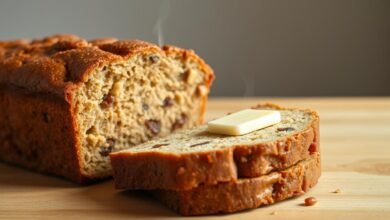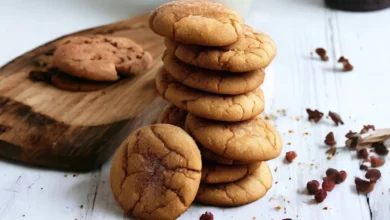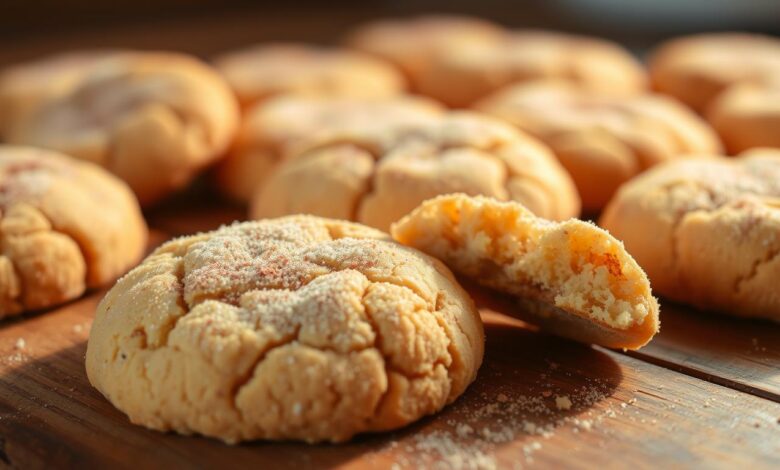
Snickerdoodle Cookies, Soft, Chewy, and Irresistible — You remember the first bite — warm, tender, and a little magical. Maybe you baked with a parent or found comfort in a bakery on a cold afternoon. That memory is why this recipe matters: it reconnects you with simple, honest baking.
These snickerdoodle cookies deliver a soft, chewy interior and a lightly crisp exterior from a roll in cinnamon sugar. Cream of tartar and baking soda add the signature tangy flavor and the puffy bite you expect.
You’ll use familiar ingredients — unsalted butter, sugar, eggs, and all-purpose flour — and learn tips to avoid overworking dough. Typical bakes run 9–11 minutes at 350°F or about 10 minutes at 375°F, then cool briefly on the sheet before moving to a rack.
Key Takeaways
- This reliable recipe focuses on classic texture and tang.
- Roll dough twice in cinnamon sugar for better coating.
- Gentle mixing preserves the soft, chewy crumb.
- Short bake times prevent overbaking and keep tenderness.
- Simple pantry ingredients and clear steps make it easy to follow.
Why You’ll Love These Soft and Chewy Snickerdoodle Cookies
Every bite here is about a tender center and a lightly crisp edge that feels like home.
You get a soft chewy texture that holds up for days when stored in an airtight container at room temperature. Underbake by a minute or two—about 9–11 minutes—and the interior stays plush while the exterior firms.
Double-rolling the dough in cinnamon sugar gives full flavor and a classic crust. No chill time is required, so this is a fast, weeknight-friendly recipe. Baking for short minutes makes these ideal when you want quick results and reliable texture.
- You can bake ahead and keep the cookie soft at room temperature.
- Cool briefly on the sheet, then transfer to a wire rack cool to protect the center.
- If you love chocolate chip cookies, these are just as easy to gift and enjoy.
| Tip | Why it helps | When to use |
|---|---|---|
| Underbake 9–11 minutes | Keeps center chewy | Weeknight bakes |
| Double roll in cinnamon | Full coating and aroma | Every batch |
| Cool on sheet then rack | Prevents overbaking | Immediately after baking |
Snickerdoodle Cookies
What marks the classic is a crinkled top, a cinnamon sugar crust, and a faintly tangy bite.
The hallmark: cinnamon sugar coating and a tender, tangy center.
You’ll recognize authentic snickerdoodle by generous coating and a center that stays tender, not dry. The dough is portioned into balls, rolled in a small bowl of cinnamon sugar, and often rolled twice for extra coating.
The secret: cream of tartar vs baking powder
Cream tartar teams with baking soda to give that mild tang and gentle lift. That reaction produces the slightly puffy structure and the lightly crinkled top you expect.
Some bakers reach for baking powder as a substitute, but you trade away the classic tang and signature texture. If you want traditional flavor and shape, keep the tartar and baking soda in the recipe.
- You mix dry ingredients in a bowl and cream butter with sugar separately before combining.
- Shape dough into balls, roll in a small bowl of cinnamon sugar, then bake for just minutes until edges are barely golden.
- Pull the pan early; carryover heat finishes the centers and preserves chewiness.
| Feature | What it does | Why it matters |
|---|---|---|
| Cream tartar + baking soda | Creates tang and lift | Gives crinkled top and soft interior |
| Double coating | Stronger cinnamon sugar flavor | More classic crust and aroma |
| Short oven time | Prevents dry crumb | Keeps cookie tender and puffy |
Ingredients & Smart Substitutions
A few smart swaps let you shape the dough’s softness without changing the base recipe.
Dry ingredients: Use all-purpose flour, cream of tartar, baking soda, salt, and ground cinnamon. The acid in cream and tartar reacts with baking soda to create lift and that faint tangy flavor.
Wet ingredients: Unsalted butter, granulated sugar, eggs, and vanilla extract form the backbone. If you use salted butter, reduce added salt by about 1/4 teaspoon.
Cinnamon-sugar coating
A reliable ratio is about 1/4 cup sugar to 1 to 1.5 tablespoons cinnamon for a bold crust without bitterness. You can tweak this to taste.
Smart swaps and measuring tips
- Swap half the all-purpose flour with cake flour for a softer crumb.
- Measure by teaspoon and cup to keep dough moisture consistent.
- Use pure vanilla for richer aroma that complements the butter.
- Don’t skip cream tartar — use cream tartar to preserve classic texture and tangy flavor.
How to Make Snickerdoodle Cookies Step by Step
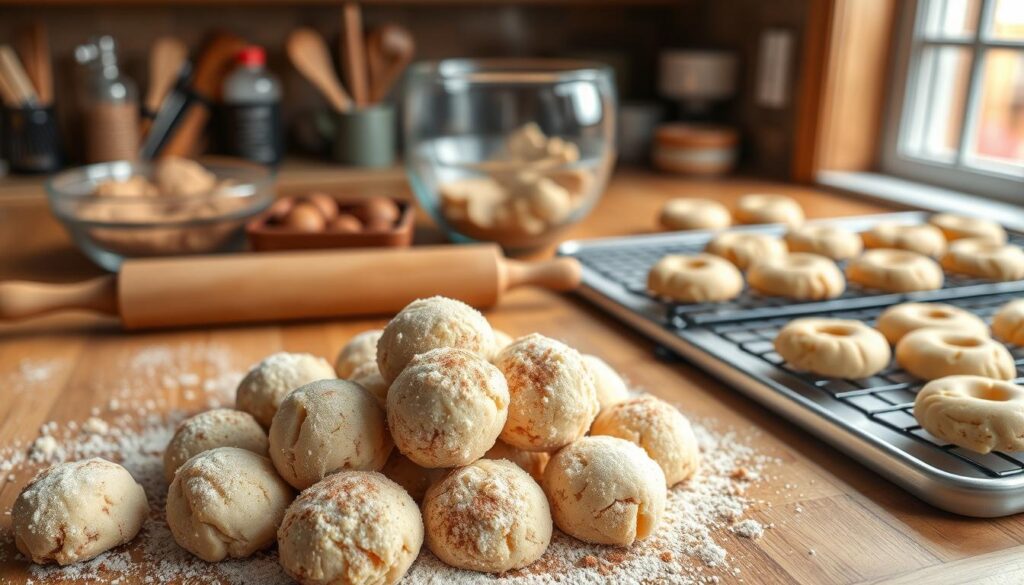
Follow a clear sequence and you’ll get soft, tangy treats with a classic cinnamon sugar crust.
Prep your oven, sheets, and cinnamon sugar
Start by preheating the oven to 350°F and lining your baking sheets. This makes browning consistent and helps the cookie dough bake evenly.
Stir cinnamon sugar in a small bowl and set it aside for quick coating when the dough is ready.
Cream butter and sugar until light and fluffy
Cream butter and sugar in a bowl for 2–5 minutes until pale and airy. This traps air and gives lift that keeps the centers tender.
Beat in eggs and vanilla until just combined.
Whisk dry ingredients for even leavening
Whisk flour, cream of tartar, baking soda, salt, and a pinch of cinnamon in a separate bowl so leaveners distribute evenly.
Combine, portion, and coat
Fold dry into wet just until the dough comes together. Overmixing tightens gluten and toughens the bite.
Portion the dough into balls, then roll each ball in cinnamon sugar. A quick second pass increases coverage and flavor.
Bake and finish
Bake 9–11 minutes until edges are lightly golden. Pull pans early so centers stay soft.
Let cookies cool on the sheet for a few minutes, then transfer to a wire rack cool to finish setting.
- Watch visual cues: puffy tops and pale centers mean they are ready to come out.
- Adjust bake time by a minute if pans run hot or cool.
Pro Tips for Soft, Puffy, and Chewy Results
Small changes in how you handle dough and heat make a big difference. These pro tips help you get a reliably soft chewy center and a lightly set edge every bake.
No chilling required today — when you might choose to chill
Most tested batches skip chilling because the dough holds shape and still bakes tender. Chill only if you want thicker, denser rounds or need to pause between prep and baking.
Underbake slightly and trust carryover heat
Pull pans a minute or two early. Letting carryover heat finish the centers keeps them moist rather than dry. For this recipe, aim for the lower end of the minutes range and watch for pale, puffy tops.
Pan color, oven accuracy, and spacing
Use light-colored sheets for even browning. Dark pans speed browning and may need reduced time.
Verify your oven with an inexpensive thermometer to check spots and adjust temperature. Space cookies so air circulates and edges set uniformly.
Final handling and measuring
Press centers gently after baking if you want a flatter profile without losing tenderness. Measure flour by spooning into the cup and leveling it. Keep butter and eggs at room temperature for proper creaming and lift.
- Keep baking soda and cream fresh so dough lifts and crinkles.
- Avoid baking powder unless you accept a different flavor and texture.
- Adjust minutes slightly for size and sheet color to keep the middle soft.
| Issue | Fix | Why it helps |
|---|---|---|
| Flat spread | Chill briefly or use light-colored sheets | Controls spread and evens browning |
| Dry centers | Underbake by 1–2 minutes | Carryover heat finishes without over-drying |
| Uneven bake | Check oven temp and space cookies | Corrects hot spots and helps edges set |
| Dense crumb | Spoon-and-level flour; use room-temperature butter | Prevents overpacking flour and ensures smooth creaming |
Easy Variations & Flavor Twists
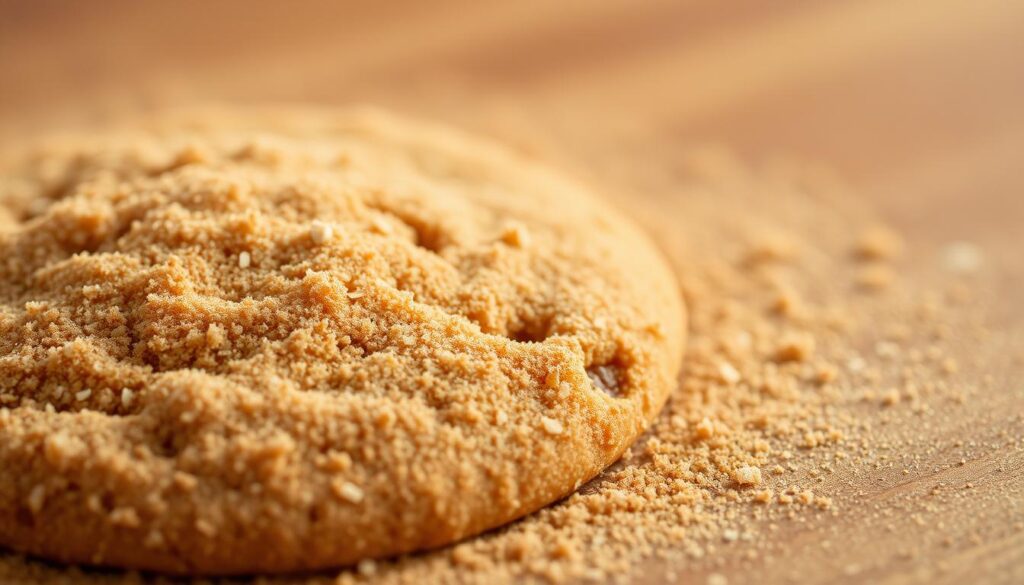
Small changes in mix-ins deliver big differences in taste and texture.
Want more spice or a gooey center? Fold in cinnamon chips to boost the cinnamon sugar aroma without changing your steps. Use about 2 to 3 tablespoons of chips per batch so the dough keeps structure and bakes evenly.
Caramel-filled centers
Tuck a soft caramel into each portion before rolling. The caramel melts into a molten center while the exterior sets.
Softer crumb with cake flour
Swap half the all-purpose flour with cake flour for a finer, ultra-soft crumb. The dough stays pliable and yields a tender, soft chewy bite.
Peanut butter and chocolate riffs
Riff with peanut butter or add chocolate chip bits while keeping the cinnamon-sugar coating. Choose semi-sweet chocolate to balance spice and flavor.
- Portion dough uniformly so add-ins bake consistently.
- Use tablespoons to measure chips or nuts to avoid overloading the dough.
- Pull pans a minute early to preserve a soft chewy center when add-ins are present.
| Variation | Add-in amount | Effect |
|---|---|---|
| Cinnamon chips | 2–3 tablespoons | Stronger spice, same bake time |
| Caramel center | 1 soft caramel each | Gooey molten interior |
| Half cake flour blend | 50% cake / 50% all-purpose flour | Finer, softer crumb |
| Peanut butter or chocolate chip | 2 tablespoons chips or 1–2 tbsp peanut butter swirls | Richer flavor, watch bake time |
Storage, Freezing, and Make-Ahead
Good storage and smart freezing turn a single bake into many perfect moments.
Room-temperature storage keeps a soft, chewy bite for 24–48 hours when you store cookies covered. Some bakers report up to 7 days in a tight airtight container, but for peak texture stick to two days.
Freeze dough balls for quick baking
Portion cookie dough into dough balls and freeze up to 2–3 months. You can freeze without a coating and roll in cinnamon sugar after thawing for best crust and even coating.
When ready, thaw dough balls about 30 minutes while you preheat the oven. Baking from thawed dough gives the most consistent spread and texture across each cookie.
Freeze baked cookies and reheating
Freeze baked snickerdoodle cookies up to 3 months. Thaw to room temperature on a wire rack so surface crispness and interior softness return evenly.
- Separate layers with parchment to prevent sticking.
- Label dates on containers to rotate stock efficiently.
- Pre-coated dough balls work, but note the surface coating may change after freezing.
- Keep leaveners fresh and remember to use cream tartar so frozen batches lift and crinkle as expected.
| Storage Type | Time | Tip |
|---|---|---|
| Room temperature | 24–48 minutes (hours) | Cover to keep soft |
| Frozen dough balls | 2–3 months | Thaw ~30 minutes before baking |
| Frozen baked | Up to 3 months | Thaw on a rack to room temperature |
Conclusion
This recipe gives you a reliably tender, slightly tangy cookie that’s quick to make and easy to share.
You now have a dependable workflow for Snickerdoodle Cookies that yields soft, puffy results with a warm cinnamon crust. Keep cream tartar and baking soda fresh to preserve that signature tang and lift.
Use room-temp butter, measured flour, and short minutes in the oven. Cool on sheets briefly, then move to a rack to protect the center.
Store or freeze dough and baked goods for later. Try variations—cinnamon chips, caramel centers, peanut butter, or chocolate chip riffs—while preserving the classic flavor and texture.

